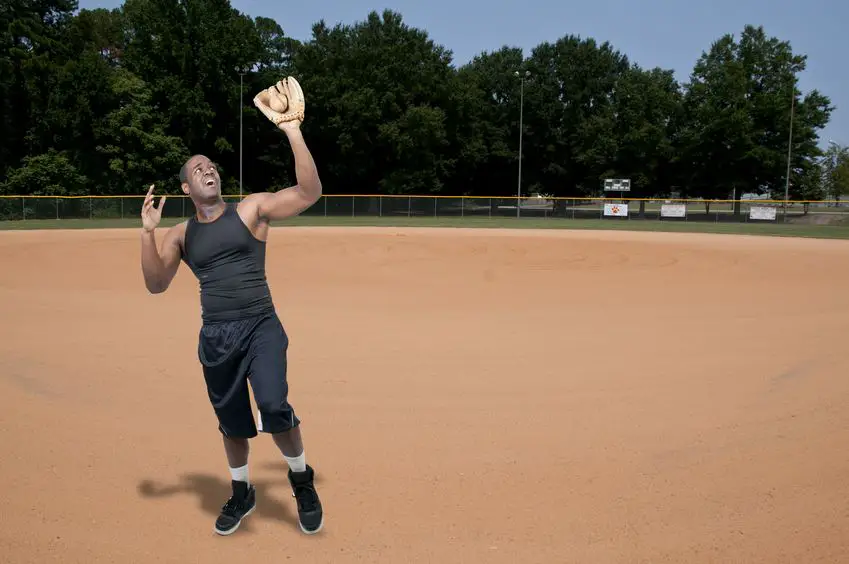
In my opinion, the most important tool in catching a long fly ball is the ability to detect it. This gives the player time to successfully react if done correctly. Often the height and speed of the ball will be an indicator. Once this is recognized, then the initial footwork will make the difference in whether a catchable long ball is caught or not.
Softball Long Fly Ball
Backpedaling to catch a fly ball is not recommended. This puts the player off balance as she is trying to keep her eye on the ball in addition to not being able to see what is behind her. A drop step on the other hand, keeps the body balanced as the foot stepping back not only provides a good center of gravity distribution but it also opens up the vision so that the fielder can keep an eye on the ball and where she is going at the same time.
If the ball is to the left of the fielder, she will take her first step back with her left foot in the direction that she is going to move to the ball. If she is right handed, she will head in the direction of the ball, and a few steps before she gets to the ball she will stretch her glove out and catch it. If she is left handed and the ball is coming to her left, she will need to cross her glove over her body a few steps before she gets to the ball in order to catch it. The angle that she takes in her first step will depend on how close to her the ball is.
The same will be true if the ball is heading to the left side of the fielder. If the long fly ball is coming right at her and over her head, she might have to switch sides as she is moving back to get the ball. This might also occur if it is windy and the ball is moving in flight.
If the long fly ball is moving fast and the fielder is not going to get it, she will estimate where the ball is going to land and then simply turn 180 degrees and run in that direction, keeping her eyes in front of her to see where the ball lands. I have done this myself and it was very effective in minimizing the runners advance on the bases. This way the player is not wasting time trying to catch a ball that is not catchable and spending the time instead on getting to the ball and fielding it to get it in as fast as possible.
When possible, players need to stay behind the ball and keep it from getting away from them and to the fence. This is why on a ball up the middle, running at an angle to where the ball is going is much more effective than trying to cut the ball off laterally. This is also why backup is so important. The outfield is the last line of defense and needs to do everything they can to prevent the ball from getting away from the fielders.
Anticipation is a tool that all outfielders and infielders for that matter should have when on the field. A good way to have as much information as possible is to know the batters. If the player knows a specific batter always hits long balls, she can anticipate that it will occur. By watching her feet and her warmup swing, she can get an idea of the direction of the hit. Keeping in mind of course that anything can happen and the batter could actually bunt instead, depending on the offensive situation.
Other Factors in fielding the long fly ball:
The speed and consistency of the pitcher can have an effect on the flight and speed of the ball. A faster pitcher can create a longer fly ball because the ball will come off the bat faster due to the reaction to the contact from the bat. A slower pitcher of course might produce a shorter fly ball, unless of course the hitter has a lot of strength and can maximize her power in her swing.
Being able to defend a fly ball will always be helped by knowing the field and taking note of the weather. Is there a wind and if so, which direction is it blowing. Are the any obstacles on the field which many teams face depending on where they play. Where is the sun if it is not cloudy? If it is shining, this will create a need to shield it to prevent blind spots depending on which direction it is shining.
At the end of the day, the more information the fielders can have on the entire situation, the better the chances for success. Knowing the batter, the pitchers abilities, what pitch she is going to throw and the weather will give the fielders an extra edge. Add a good psychological disposition of the fielder and you have almost everything needed to take care of business. Keeping in mind of course… the unexpected.
Practice makes perfect for fielding the long fly ball. Having the outfield set up and giving them opportunities to go after those hits will not only increase the likelihood of success in a game, but it will also develop confidence for when they face the real situation. Backup needs to be stressed in all situations but especially on those deep hits. Minimizing the advancement of the batter and any runners on base is critical to a good defense.

